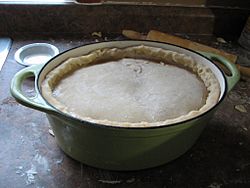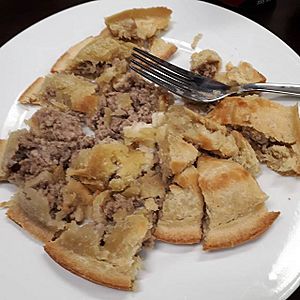Tourtière facts for kids

Tourtière du Lac-Saint-Jean, ready to be put into the oven for baking
|
|
| Type | Meat pie |
|---|---|
| Course | main dish |
| Place of origin | Quebec, Canada |
| Region or state | Quebec, New Brunswick and New England (US) |
| Main ingredients | pork, veal, beef, or fish; game meat; potatoes |
| Other information | Eaten: New Year's Eve, Christmas, Christmas Eve, Thanksgiving |
Tourtière is a yummy meat pie from Canada. It comes from the Quebec area. People usually make it with pork, veal, or beef. Sometimes, they add potatoes too! You might even find it made with wild game meat.
This special pie is often eaten during holidays. It's a big part of Christmas Eve (called réveillon) and New Year's Eve meals in Quebec. It's also very popular in New Brunswick. You can even find it in grocery stores all over Canada any time of year.
Tourtière is not just for Quebec. It's a traditional dish for French Canadian families. They enjoy it across Canada and in parts of the United States. In the New England area of the U.S., like Maine and Massachusetts, immigrants from Quebec brought this tasty pie with them a long time ago.
There are many ways to make tourtière. The meat used often depends on what is easy to find nearby. If you are near the coast, you might find fish like salmon inside. Inland, people often use pork, beef, or even rabbit. The name "tourtière" comes from the special dish it was first cooked in.
Tourtière du Lac-Saint-Jean is a very famous type of tourtière. It became a traditional dish in the Saguenay region of Quebec after World War II. It has changed a bit over the years.
In the 1700s, a dish called "sea pie" was popular. It was eaten by both French and British settlers. This "sea pie" seems to be an early version of the Tourtière du Lac-Saint-Jean.
Contents
Different Kinds of Tourtière Pies
Tourtière from Saguenay-Lac-Saint-Jean
The tourtières from the Saguenay-Lac-Saint-Jean area are deep-dish meat pies. They are cooked slowly for a long time. These pies are made with potatoes and different kinds of meats. Often, they include wild game meat. The meat is cut into small cubes, not ground.
In other parts of Quebec and Canada, people call this type of pie Tourtière du Lac-Saint-Jean. They also call it tourtière saguenéenne. This helps tell it apart from other tourtières made with ground meat. But in the Saguenay-Lac-Saint-Jean area, they just call their special pie "tourtière." They call pies with ground meat "pâté à la viande" (which means "meat pie").
Montreal Style Tourtière
Tourtière made in Montreal uses only finely ground pork. It can be hard to find pork ground this fine in other places. After browning the meat, water is added. Spices like cinnamon and cloves give it a special taste. Many people like to eat this tourtière with ketchup. Others prefer it with maple syrup, molasses, or cranberry sauce.
This Montreal version is not as famous as the original tourtière. But you can still find it in many places across Canada and nearby areas.
Manitoba Tourtière
Tourtière is a very important part of holiday meals for French Canadians in St. Boniface. It's also popular in the French-speaking parts of Manitoba. The browned meat is seasoned with different spices. These can include savory, nutmeg, cloves, cinnamon, and celery salt. Dry mustard, salt, and pepper are also used.
Acadia Tourtière
Acadian tourtière is also called pâté à la viande. "Pâté" means casserole or pie. This pie is usually made with pork. But it can also have chicken, hare, and beef. Pâté à la viande changes a bit from one region to another. You'll find different versions in New Brunswick, Nova Scotia, and Prince Edward Island. In some towns like Petit-Rocher, they make small pies. These are called petits cochons, which means "little pigs."
See also
 In Spanish: Tourtière para niños
In Spanish: Tourtière para niños


